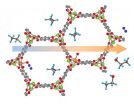(Press-News.org) Over the past several decades, neurostimulation techniques such as transcranial direct current stimulation (tDCS) have gradually gained favour in the public eye. In a new report, published yesterday in the prestigious scientific journal Neuron, IRCM ethics experts raise important questions about the rising tide of tDCS coverage in the media, while regulatory action is lacking and ethical issues need to be addressed.
TDCS is a non-invasive form of neurostimulation, in which constant, low current is delivered directly to areas of the brain using small electrodes. Originally developed to help patients with brain injuries such as strokes, tDCS is now also used to enhance language and mathematical ability, attention span, problem solving, memory, coordination, and even gaming skills. Recently, states the report, tDCS has caused excitement in the lay public and academia as a ''portable, painless, inexpensive and safe'' therapeutic and enhancement device.
"Despite these claims, the effects of tDCS are hard to predict," explains Eric Racine, PhD, Director of the Neuroethics research unit at the IRCM who supervised the research project. "The safety and efficacy of tDCS have only been demonstrated in controlled laboratory settings and, without supervision, the use of tDCS for enhancement might cause serious adverse effects such as temporary respiratory paralysis."
The report shows the amount of publicly-available information on tDCS has increased dramatically in recent years, both in academic literature and print media articles. IRCM researchers analyzed the available information and found a considerable mismatch in tone and focus between academic and print media articles.
While academic articles focused on therapeutic and investigative uses of tDCS, discussions in print media articles mainly concentrated on potential enhancement uses, as well as therapeutic applications. In addition, media discussions have been optimistic, with little information concerning ethical issues, therapeutic limitations, or side effects that could result from widespread use, whereas academic articles usually involved a more balanced discourse.
"We encountered strong and potentially misleading statements about the real-world effects and applications of tDCS in print media headlines," says Veljko Dubljevic, PhD, postdoctoral fellow in the IRCM's Neuroethics research unit and first author of the report. "In our entire sample of media articles, only 3.5 per cent advised caution or mentioned the possibility of adverse effects."
Given the nature of tDCS and the lack of oversight governing its use, the report explains that academic and print media discourse could shape the public's risk-benefit perceptions, impact the uptake of this technology, and, consequently, lead to negative implications for ethical and regulatory oversight.
"With the rapid evolution of tDCS in the public domain and in academia, we recommend three areas of action to tackle the social, ethical and policy implications," adds Dr. Dubljevic. "First, to curtail misunderstandings about tDCS, professional societies, researchers and government agencies should work toward increasing neuroscientific literacy by providing objective neutral data to the media and the public. Second, tDCS devices, as well as their marketing and manufacturing standards, need to be monitored and regulated. Training and licensing procedures should also be considered. Finally, we believe that physicians and other clinicians should become actively engaged in the discussion about ethical, clinical and policy aspects of tDCS."
"The current regulatory gap means that tDCS is readily available as a service, product, or even a homemade device, in many countries without any guidance being provided by policy makers," concludes Dr. Racine. "A response to the policy and regulatory aspects of tDCS is urgently needed."
INFORMATION:
About the study
This research project was funded by the Social Sciences and Humanities Research Council. Authors for this report also included Victoria Saigle, research assistant in the IRCM's Neuroethics research unit. For more information, please refer to the article published online by Neuron.
About Eric Racine
Eric Racine is Associate IRCM Research Professor and Director of the Neuroethics research unit. He obtained a PhD in applied human sciences (bioethics) from the Université de Montréal. Dr. Racine is Associate Research Professor in the Department of Medicine (accreditation in Social and Preventive Medicine and in Bioethics) at the Université de Montréal. He is also Adjunct Professor in the Department of Medicine (Division of Experimental Medicine) and the Department of Neurology and Neurosurgery at McGill University. Dr. Racine is an affiliate member of the Biomedical Ethics Unit at McGill University. He is a Research Scholar from the Fonds de recherche du Québec – Santé. Dr. Racine's research is designed to improve the ethical aspects of quality of care, research practices and public communications in the domain of clinical and basic neuroscience. For more information, visit http://www.ircm.qc.ca/racine.
About Veljko Dubljevic
Veljko Dubljevic is a postdoctoral fellow in the Neuroethics research unit at the IRCM. He obtained a PhD in political science and political theory at the University of Belgrade, and completed the qualification requirements for a PhD in philosophy and neuroethics at Universities of Tübingen and Stuttgart (dissertation defense scheduled in June). Dr. Dubljevic's primary research interests include the ethics of neuroscience and technology, and the neuroscience of ethics. His other interests include bioethics, political theory, moral theory, business ethics, and philosophy of law. He has over 30 publications in moral, legal and political philosophy and in neuroethics. He is also engaged in the activities of the International Neuroethics Society (INS) and serves as a member of the INS's Communications Committee.
About the IRCM
Founded in 1967, the Institut de recherches cliniques de Montréal is currently comprised of 35 research units in various fields, namely immunity and viral infections, cardiovascular and metabolic diseases, cancer, neurobiology and development, systems biology and medicinal chemistry. It also houses four specialized research clinics, eight core facilities and three research platforms with state-of-the-art equipment. The IRCM employs 425 people and is an independent institution affiliated with the Université de Montréal. The IRCM Clinic is associated to the Centre hospitalier de l'Université de Montréal (CHUM). The IRCM also maintains a long-standing association with McGill University. The IRCM is funded by the Quebec ministry of Economy, Innovation and Export Trade (Ministère de l'Économie, de l'Innovation et des Exportations).
What is being said in the media and academic literature about neurostimulation?
A new report by IRCM ethics experts raises important questions and concerns about tDCS
2014-05-22
ELSE PRESS RELEASES FROM THIS DATE:
EuroPCR 2014 examines whether science translates into practice with new session format
2014-05-22
22 May 2014, Paris, France: The value of analysing published clinical trials and the benefit of informed discussion were highlighted yesterday when the ACCOAST trial data were discussed in a new session format—Will this trial change my practice?— at EuroPCR 2014. ACCOAST trial results demonstrate that pre-treatment with prasugrel in NSTEMI patients undergoing percutaneous coronary intervention (PCI) is inferior to treatment with the drug after angiography. Several other trials are also being scrutinised in the same format, which ends with a discussion with the audience ...
New details on microtubules and how the anti-cancer drug Taxol works
2014-05-22
A pathway to the design of even more effective versions of the powerful anti-cancer drug Taxol has been opened with the most detailed look ever at the assembly and disassembly of microtubules, tiny fibers of tubulin protein that form the cytoskeletons of living cells and play a crucial role in mitosis. Through a combination of high-resolution cryo-electron microscopy (cryo-EM) and new methodology for image analysis and structure interpretation, researchers with the Lawrence Berkeley National Laboratory (Berkeley Lab) and the University of California (UC) Berkeley have produced ...
Which way is up?
2014-05-22
What do sled dogs and cell clusters have in common? According to research by UC Santa Barbara's Denise Montell, they both travel in groups and need a leader to make sure they all follow in the same direction.
Montell, Duggan Professor of Molecular Cellular and Developmental Biology, and colleagues worked on three independent projects involving E-cadherin, a protein found in epithelial cells throughout the body. The researchers used fruit-fly ovaries to uncover the role played by E-cadherin in collective cell migration. Their findings are reported today in the journal ...
Eumelanin's secrets
2014-05-22
CAMBRIDGE, Mass-- Melanin — and specifically, the form called eumelanin — is the primary pigment that gives humans the coloring of their skin, hair, and eyes. It protects the body from the hazards of ultraviolet and other radiation that can damage cells and lead to skin cancer, but the exact reason why the compound is so effective at blocking such a broad spectrum of sunlight has remained something of a mystery.
Now researchers at MIT and other institutions have solved that mystery, potentially opening the way for the development of synthetic materials that could have ...
US obesity epidemic making all segments of the nation fatter, study finds
2014-05-22
The nation's obesity epidemic is striking all groups of Americans, affecting those with more education and those with less education, as well as all ethnic groups, according to a new analysis that challenges prevailing assumptions about the reasons why the nation is getting heavier.
While some differences in weight are evident between groups based on race and education levels, all Americans have been getting fatter at about the same rate for the past 25 years, even as the nation saw increases in leisure time, increased availability of fruit and vegetables, and increases ...
Being Sardinian puts a smile on the face of the elderly
2014-05-22
Residents of the Italian island of Sardinia are known for their longevity. Now, a new study also shows that elderly Sardinians are less depressed and generally are in a better mental frame of mind than peers living elsewhere. The study, led by Maria Chiara Fastame and Maria Pietronilla Penna of the University of Cagliari in Italy and Paul Hitchcott from the Southampton Solent University in UK, is published in Springer's journal Applied Research in Quality of Life.
Various tests to measure the mental state and capacity of elderly people were performed on 191 cognitively ...
Gene therapy extends survival in an animal model of spinal muscular atrophy
2014-05-22
New Rochelle, NY, May 22, 2014—To make up for insufficient amounts of SMN protein, the cause of the inherited neuromuscular disease spinal muscular atrophy (SMA), researchers have successfully delivered a replacement SMN1 gene directly to the spinal cords of animal models of SMA. A new study demonstrating that enough copies of the SMN1 gene can be delivered to the spinal cord motor neurons to extend the survival of the treated animals is published in Human Gene Therapy, a peer-reviewed journal from Mary Ann Liebert, Inc., publishers. The article is available free on the ...
JILA study finds crowding has big effects on biomolecules
2014-05-22
Crowding has notoriously negative effects at large size scales, blamed for everything from human disease and depression to community resource shortages. But relatively little is known about the influence of crowding at the cellular level. A new JILA study shows that a crowded environment has dramatic effects on individual biomolecules.
In the first data on the underlying dynamics (or kinetics)of crowded single biomolecules , reported in Proceedings of the National Academy of Sciences,* JILA researchers found that crowding leads to a 35-fold increase in the folding rate ...
From separation to transformation: Metal-organic framework shows new talent
2014-05-22
This gift from science just keeps on giving. Measurements taken at the National Institute of Standards and Technology (NIST) show why a material already known to be good at separating components of natural gas also can do something trickier: help convert one chemical to another, a process called catalysis. The discovery is a rare example of a laboratory-made material easily performing a task that biology usually requires a complex series of steps to accomplish.
The material is a metal-organic framework (MOF), one of a class of substances whose porosity, high surface area ...
Don't blink! NIST studies why quantum dots suffer from 'fluorescence intermittency'
2014-05-22
Researchers at the National Institute of Standards and Technology (NIST), working in collaboration with the Naval Research Laboratory, have found that a particular species of quantum dots that weren't commonly thought to blink, do.
So what? Well, although the blinks are short—on the order of nanoseconds to milliseconds—even brief fluctuations can result in efficiency losses that could cause trouble for using quantum dots to generate photons that move information around inside a quantum computer or between nodes of a future high-security internet based on quantum telecommunications.
Beyond ...
LAST 30 PRESS RELEASES:
Sleeping in on weekends may help boost teens’ mental health
Study: Teens use cellphones for an hour a day at school
After more than two years of war, Palestinian children are hungry, denied education and “like the living dead”
The untold story of life with Prader-Willi syndrome - according to the siblings who live it
How the parasite that ‘gave up sex’ found more hosts – and why its victory won’t last
When is it time to jump? The boiling frog problem of AI use in physics education
Twitter data reveals partisan divide in understanding why pollen season's getting worse
AI is quick but risky for updating old software
Revolutionizing biosecurity: new multi-omics framework to transform invasive species management
From ancient herb to modern medicine: new review unveils the multi-targeted healing potential of Borago officinalis
Building a global scientific community: Biological Diversity Journal announces dual recruitment of Editorial Board and Youth Editorial Board members
Microbes that break down antibiotics help protect ecosystems under drug pollution
Smart biochar that remembers pollutants offers a new way to clean water and recycle biomass
Rice genes matter more than domestication in shaping plant microbiomes
Ticking time bomb: Some farmers report as many as 70 tick encounters over a 6-month period
Turning garden and crop waste into plastics
Scientists discover ‘platypus galaxies’ in the early universe
Seeing thyroid cancer in a new light: when AI meets label-free imaging in the operating room
Neutrophil-to-lymphocyte ratio may aid risk stratification in depressive disorder
2026 Seismological Society of America Annual Meeting
AI-powered ECG analysis offers promising path for early detection of chronic obstructive pulmonary disease, says Mount Sinai researchers
GIMM uncovers flaws in lab-grown heart cells and paves the way for improved treatments
Cracking the evolutionary code of sleep
Medications could help the aging brain cope with surgery, memory impairment
Back pain linked to worse sleep years later in men over 65, according to study
CDC urges ‘shared decision-making’ on some childhood vaccines; many unclear about what that means
New research finds that an ‘equal treatment’ approach to economic opportunity advertising can backfire
Researchers create shape-shifting, self-navigating microparticles
Science army mobilizes to map US soil microbiome
Researchers develop new tools to turn grain crops into biosensors
[Press-News.org] What is being said in the media and academic literature about neurostimulation?A new report by IRCM ethics experts raises important questions and concerns about tDCS




